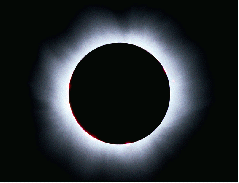TheSuns corona is the gas consisting of hot ionized gas or plasma surrounding the Sun, extending millions of km into space. It is normally made invisible by the Suns glare, but is clearly visible during a solar eclipse.

The temperature of the corona is greater than a million degrees Kelvin, indicated by the presence of highly ionized iron, especially the green FeXIV line at 5303Å and the red line FeX at 6374Å.
Light from the corona has three origins.
The K-corona is created by the Suns light scattering off freeelectrons;Doppler broadeningof the reflected photospheric absorption lines completely obscures them, giving the spectral appearance of a continuum with no absorption lines.
The F-corona is created by sunlight bouncing off dust particles, and is observable because its light contains the Fraunhofer absorption lines that are seen in raw sunlight; the F-corona extends to very highelongationangles from the Sun, where it is called thezodiacal light.
The E-corona is due to spectral emission lines produced by ions that are present in the coronal plasma. It may be observed in broad, forbiddenor hot emission linesand is the main source of information about the corona's composition.
The sun's corona, separated from the photosphere by the chromosphere, is two hundred times hotter than the Suns photosphere, which has a temperature of around 5800 degrees Kelvin. The corona is only one thousandth billionth as dense as the photosphere, and produces only about one-millionth as much visible light. The mechanism heating the corona is unknown but likely possibilities include induction by the Sun'smagnetic fieldandsonicpressure waves from the surface of the Sun.
The corona is not always evenly distributed over the surface of the sun. During periods of quiet, the corona is confined to thearea around the equator, withcoronal holescovering thepolarregions and when the Sun is active the corona is more evenly distributed, though it is most prominent in areas withsunspotactivity. Thesolar and sunspot cyclesspan approximately 11 years, fromsolar minimumtosolar maximum, where the solar magnetic field is continually wound up due to differential rotationas the equator rotates quicker than the poles. Associated with sunspots arecoronal loops ofmagnetic flux, exiting from the solar interior. The magnetic flux pushes the hotterphotosphereaside, exposing the cooler plasma below, thus creating the relatively dark sunspot.
Active regionsin the corona are groups of loops of gas connecting points of opposite magnetic polarity in the photosphere. They generally distribute in two zones of activity, which are parallel to the solar equator. The average temperature is between two and four million Kelvin, while the density goes from 10^9to 10^10particle per cm^3 . The active regions are associated with sunspotsandfaculae, spicules,Hαfilaments,plages in the chromosphere and transition region,flares andcoronal mass ejectionshappening in the corona and chromosphere.
Solar material ejected from the photosphere into a magnetic loop plasma fis heated from under 6000 K to well over 10^6K from the photosphere, through the transition region, and into the corona. Often, the solar plasma will fill these loops from one one loop of the foot to another, flowing along the loop.
Coronal loops may have lifetimes varying from seconds to days. Usually coronal loops lasting for long periods of time are known assteady stateorquiescentcoronal loops, where there is a balance in loop energy sources and sinks.
